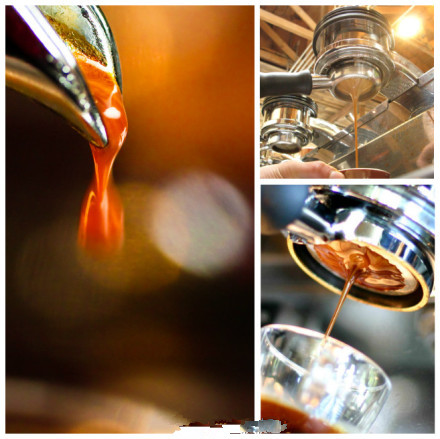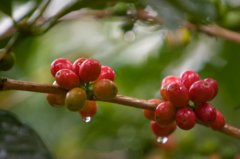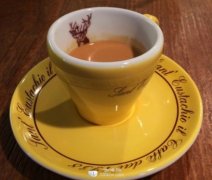Coffee roasting knowledge Why roast coffee beans?
Why roast coffee beans? This is because roasting gives off aroma of coffee and makes different kinds of coffee give out different flavors. Without this process, the unique taste of coffee will be greatly reduced. Roasting causes coffee to produce coffee oil, which gives coffee beans a strong aroma. The most outstanding feature of this fragrance is that it is volatile and soluble in water. Therefore, people can not only ask about the mellow smell of coffee beans, but also pour it into the cup and taste it carefully.

The raw coffee beans for export are not the dark brown beans we often see in cafes with a luster of vegetable oil and a burst of coffee-scented beans. Coffee beans can only be roasted to become coffee beans for grinding and drinking. Of course, this is just a strange modern way, because in the early days, Ethiopians used the fruits of coffee to make wine. Or brew coffee fruit to make drinks. Nowadays, even if someone wants to try this ancient way of drinking coffee, ordinary people can't find fresh coffee fruit in North America and Europe, which consume a lot of coffee. Roasting coffee beans, then grinding and brewing them has become a classic process for people to enjoy coffee.
Baking is the beginning of this process. 80% of the taste of coffee is determined by baking. It can be seen that roasting is very important in coffee production.
Why roast coffee beans? This is because roasting gives off aroma of coffee and makes different kinds of coffee give out different flavors. Without this process, the unique taste of coffee will be greatly reduced. Roasting causes coffee to produce coffee oil, which gives coffee beans a strong aroma. The most outstanding feature of this fragrance is that it is volatile and soluble in water. Therefore, people can not only ask about the mellow smell of coffee beans, but also pour it into the cup and taste it carefully.
Baking, as the name implies, is to provide heat to coffee beans, causing a series of chemical changes inside. First of all, the starch in raw beans will be converted into sugars and acids because of high temperature, while substances such as cellulose will be carbonized differently. Water and carbon dioxide evaporate, while proteins are converted into enzymes, which combine with the rest of the fat to form an oil film on the surface of coffee beans. Coffee beans swell when roasted, a bit like popcorn, and interestingly, coffee crackles during roasting, just like we use microwave popcorn. But because the skin on the surface of coffee beans is very tough, we usually don't see coffee beans crack like popcorn.
We often see that roasted coffee beans have different shades of color, on the one hand, this may be due to different types of individual coffee beans, and on the other hand, the main reason for this color difference is the different degree of roasting. In the most popular language, the degree of baking can be interpreted as the heat of baking. Take the most classic example of carbonated coffee, a French roasted coffee that is highly carbonized, dark brown and carbon black due to its deep roasting (either because of the high temperature during baking, or because of the long baking time, or both, depending on the situation). It is generally believed that carbonized coffee tastes bitter, which comes not only from caffeine but also from carbonized coffee beans.
Coffee roasting is divided into the following degrees:
1. Very shallow baked Light Roast
In the mildest baking method, the beans are yellowish brown and the aroma and concentration are mild and light, which can be used as a standard for identification in the early stages of baking.
2. Shallow baking / cinnamon baking Cinnamon Roast
As the name suggests, the beans are cinnamon-colored, slightly thicker than very light roasted, and refreshing in taste.
3. Medium baked Medium Roast
The beans are chestnut, sour and bitter have been released, its taste is deeper than light roasting, fresh aroma, mild taste, suitable for brewing American coffee.
4. Medium and deep baked High Roast
The beans are tea-brown and give people a slightly stronger impression than medium-baked beans. The aroma and color are balanced, and the bitter taste is stronger than the sour taste.
5. Deep baking / city baking City Roast
The beans are tea-brown, with a balance between sour and bitter taste, mellow and quite baked.
VI. Very Deep Baking / Deep City Baking Full City Roast
The beans are dark brown, sour and bitter. Because of bitterness, it is suitable for iced coffee.
7. French baking French Roast
Beans are dark brown, because deep roasting, beans contain fat floating to the surface, appears to be bright, bitter, roasted flavor is very strong, suitable for coffee Oulei.
8. Italian baking Italian Roast
Beans are nearly black, bitter and full-bodied, making them suitable for brewing espresso and cappuccinos.
According to the different heat sources used, the roasting of coffee can be divided into gas roasting, charcoal roasting and infrared roasting, of which the most common one is gas roasting, the temperature is controlled between 200 and 300 degrees, and the temperature should be adjusted from time to time as needed. Commercial baking tools are usually large machines, usually cylindrical containers with a diameter of more than two meters, with a heat source at the bottom, and a stirring tool inside the container that constantly stirs the coffee beans, while the beans are easy to rotate. the purpose is to heat the coffee beans evenly.
When it comes to fried meat, laymen always think it's difficult. But as long as you can really grasp a few key points, it will not be very difficult. Here we will introduce you to the method of "manual frying" using hand strainer.
1. First prepare 100 grams of raw coffee beans, and remove them if there are any broken coffee beans. Then put the raw coffee beans in the filter, close the lid, open the gas to medium fire, hold the filter about 20-30 centimeters above the gas, swing it in a round way, and bake patiently.
2. At the beginning, it may not be easy, but after you get used to it, you can skillfully increase or decrease the degree of frying according to your own preference.
3. In addition to the filter with handle is the most suitable, it can also be a thick-bottomed wok or pottery pot (plain clay pot). However, because the heat is difficult to control, attention should be paid to avoid burning coffee beans. In addition, simple manual ovens and electric ovens can also be used for frying.
4. after frying, once again confirm whether there are defective beans or charred coffee beans, if so, remove them by hand, and then put them in a bottle or can for one or two days.
5. if you want to use the fried coffee beans within a week, you can keep them at room temperature; if not, keep them in the refrigerator, which is the best way to preserve them. Each time you use it, just take out the necessary amount and grind it into pieces. It takes about two weeks to maintain the inherent flavor of coffee beans.
To fry coffee beans by hand:
1. Put the raw coffee beans into a filter and close the lid.
two。 Repeatedly turn the circle to wobble and evaporate the water in the beans.
3. After 5-6 minutes of baking, the beans turn light brown.
4. After the first burst, the darker the color.
5. Pan-fry and pour into the plate.
6. Quickly fan the coffee beans with a fan.
Note: strainer with handle can be bought in hardware store or coffee shop. The raw coffee beans to be prepared are more suitable for beginners in Central and South America (Peru, Cuba, Mexico, Brazil, etc.). Pick out the defective beans by hand.
Put the beans into a filter with a handle and close the lid. Keep a certain amount of heat in the open heat, reverse the round swing of the earth, and make the water evaporate.
Carefully let the fire bake to every corner of the strainer, and be careful not to scorch the beans, but concentrate on swinging the strainer. After the water evaporates, pay attention to smoke, color, fragrance and sound.
When the popping sound of Battles goes off for ten to fifteen minutes, when the sound is still, there will be a second popping sound that lasts for fifteen to twenty minutes. As the status and types of coffee beans are different, it can be judged by the color and sound of the end.
After pouring into the plate, use the cold air of the fan or hairdryer to cool it quickly. The roasted coffee beans will be reduced to about 85 grams.
Taste it (cup test) to see if the degree of frying is appropriate. At this time, it is the most tense and happy time. Let's try some delicious coffee made by ourselves.
Note: during roasting, there will be thick smoke and fragrance, and the skin of coffee beans will bounce off everywhere. Therefore, aluminum foil should be covered around the gas stove in advance, and the portable gas stove can also enjoy the fun of frying coffee beans outdoors.
Important Notice :
前街咖啡 FrontStreet Coffee has moved to new addredd:
FrontStreet Coffee Address: 315,Donghua East Road,GuangZhou
Tel:020 38364473
- Prev

Coffee bean baking technology domestic oven roasting coffee beans
Before baking, pick out the residual beans (insect beans, fermented beans, shell beans, etc.).) Heat the upper and lower tubes of the oven, preheat 150℃, put the raw beans in the selection cage, put them in the oven, change to the upper tube heating, rotate mode, 150℃, bake for 10 minutes, raise the temperature to 230℃, bake for about 25 minutes (depending on the individual's need for baking, you can adjust the time flexibly) to remove the cage.
- Next

A brief introduction to the introduction to Coffee roasting, the complete Book of Coffee self-baking
When the author published the first edition of this book in 1996, roasting coffee beans at home was something that only tireless coffee addicts would do. At that time, roasting coffee beans was a very difficult thing to master, and roasters had to work hard to find a way to roast coffee beans to a moderate brown. Today, individuals still roast coffee beans at home.
Related
- Beginners will see the "Coffee pull flower" guide!
- What is the difference between ice blog purified milk and ordinary milk coffee?
- Why is the Philippines the largest producer of crops in Liberia?
- For coffee extraction, should the fine powder be retained?
- How does extracted espresso fill pressed powder? How much strength does it take to press the powder?
- How to make jasmine cold extract coffee? Is the jasmine + latte good?
- Will this little toy really make the coffee taste better? How does Lily Drip affect coffee extraction?
- Will the action of slapping the filter cup also affect coffee extraction?
- What's the difference between powder-to-water ratio and powder-to-liquid ratio?
- What is the Ethiopian local species? What does it have to do with Heirloom native species?

